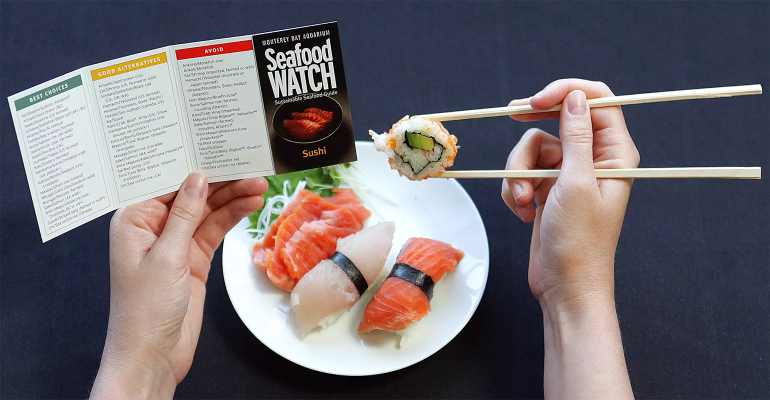Sustainable seafood resonates with shoppers — and that is proving to both an opportunity and a challenge for retailers seeking to boost activity from the eco-minded consumer segment.
Forty-seven percent of seafood consumers indicated that their seafood store’s commitment to sustainable or environmentally responsible seafood is the primary (14%) or a very important (33%) factor when deciding where to purchase seafood, stated the Power of Seafood 2023 report, published by the Arlington, Va.-based FMI.
Yet, because many consumers remain confused about what constitutes sustainability, merchandisers seeking to attract more buyers must educate shoppers what makes their seafood sustainable, analysts said.
“Sustainability has become a marketing buzzword where people increasingly know it’s important, but don’t always understand what it means,” said Kristen Stevens, senior marketing manager at the Marine Stewardship Council (MSC), a London-based organization seeking to end overfishing throughout the world.
She said misuse of the term is leading to further consumer confusion. “Sustainable can mean and imply different things to different people and it changes based on context, such as for packaging, food miles, and harvesting method,” she said.
“Different businesses use the term in different ways,” added Cory Nash, outreach manager for Seafood Watch, a program operated by the Monterey Bay Aquarium that focuses on providing clear environmental sustainability standards and science-based information on sustainable seafood.
While some parties refer to sustainable seafood as locally caught selections, others use such criteria as being ethically sourced or organic, he said. Seafood Watch defines sustainable as seafood that comes from fisheries or aquaculture operations that minimize harmful environmental impacts, assure good and fair working conditions, and support livelihoods and economic benefits throughout the entire supply chain.
“Social responsibility is critically important and often overlooked when discussing sustainability,” Nash said. “This could include areas such as protecting human rights, working toward equitable supply chains, and improving food and livelihood security.”
Some consumers categorize locally sourced seafood as sustainable. 
Seafood Watch has a three-color system that retailers and consumers can use to gauge the degree of sustainability.
Green represents the top choice and signifies the seafood was well managed and caught or farmed responsibly. Orange indicates a good alternative but with concerns about how the seafood was caught, farmed, or managed. Red implies that consumers should avoid the product because of overfishing, lack of strong management, or because it was caught or farmed in ways that harm other marine life or the environment.
The MSC has a blue fish certification label to indicate that products came from healthy fish stocks with minimal fishing impacts on the surrounding wildlife and ecosystem.
“Include labels with clear information about the species, region, fishing methods, and any relevant certifications,” Nash said. “Providing these details will allow consumers to make informed choices that support a healthy ocean.”
It is important too for retailers to spotlight sustainability at multiple shopping touchpoints to maximize influence, Stevens said. That includes e-commerce, as MSC research found that consumers spend more time and buy with greater intention when shopping online.
“This means sustainability messaging can have a greater impact,” she said. “Credible, third-party environmental certification labels help shoppers feel good about the product and are expected by the vast majority of seafood consumers.”
Such additional elements as an online link or QR code that make it simple to educate shoppers on what the sustainability certification and commitment mean can positively impact consumer confidence and, ultimately, purchases, Stevens said.
Retailers and suppliers should also consider implementing employee training programs that school workers on sustainable seafood practices, certifications, and how to communicate the importance of sustainability to customers, Nash said.
“It is incredibly important for retailers to be transparent about how you are defining ‘sustainable’ to your customers when making such claims,” he said.
The measures are important because growing misinformation about seafood and sustainability means consumers “have to do a lot of wading through fact versus fiction,” Stevens said. “This also means many are beginning to tune out and miss valuable ‘true’ information.”
Still, providing all relevant data to shoppers can be arduous, as a lack of transparency in many seafood supply chains creates difficulties for retailers in tracking the origins of seafood and assessing the products’ environmental sustainability, Nash said.
Nevertheless, it is important that merchandisers continuously seek pertinent information on seafood products from their suppliers to meet growing customer expectations, he said.
“While not all seafood consumers are focused on sustainability, those that are must have their needs and interests addressed,” the Power of Seafood reported. “Retailers can serve as a valuable resource for their shoppers in clarifying and navigating the often unclear and uncertain waters of sustainable seafood.”





